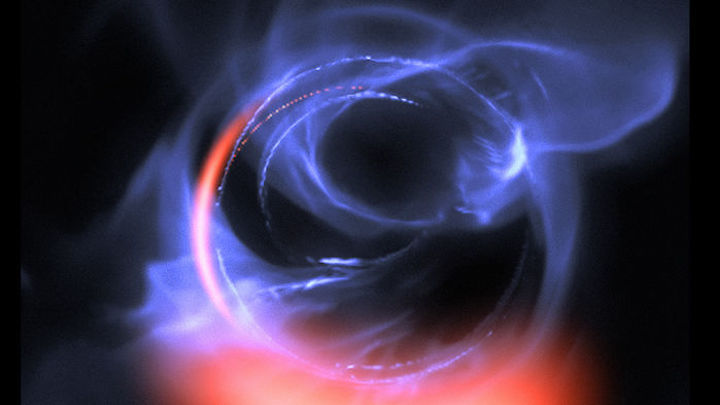1.11.2018

Earlier this year, astronomers were looking for signs that S2, the star with the closest known orbit to the supermassive black hole thought to be at the center of the Milky Way, might—as predicted by Albert Einstein—deviate from the orbital path proscribed by Newtonian gravity.
But while they were watching, they spied something else: three bright infrared flares unrelated to the star (visualization above). Those flares, the researchers reveal today, are the signs of superheated gas racing almost as close to the black hole as possible without getting sucked in—at 30% the speed of light.
Observing the action so close to the galactic center, known as Sagittarius A*, is extremely challenging because it is distant, small, and shrouded in gas and dust. The team used the world’s largest optical instrument, the European Southern Observatory’s Very Large Telescope in Chile, and combined the light of its four 8.2-meter mirrors to get the resolution of a 130-meter virtual telescope using a new instrument called GRAVITY.
Quelle: Science
+++
Confirmed: a monster black hole at the heart of the Milky Way
Long suspected, the existence of a supermassive black hole has now been ‘resoundingly’ proven. Nick Carne reports.

A simulation of material orbiting close to a black hole.
New observations by the European Space Observatory (ESO) show clumps of gas swirling around at about 30% of the speed of light on a circular orbit just outside what astronomers conclude is the black hole’s event horizon.
It’s the first time material has been seen orbiting close to the point of no return – and “a resounding confirmation of the massive black hole paradigm", according to study leader Reinhard Genzel, of the Max Planck Institute for Extraterrestrial Physics (MPE) in Germany.
"This always was one of our dream projects, but we did not dare to hope that it would become possible so soon," he says.
The findings are published in the journal Astronomy & Astrophysics.
Scientists from a consortium of European institutions used the GRAVITY instrument on the ESO’s Very Large Telescope (VLT) Interferometer in Chile to observe flares of infrared radiation coming from the accretion disc around Sagittarius A*, a bright and compact astronomical radio source at the heart of the Milky Way.
While some matter in the accretion disc – the belt of gas orbiting Sagittarius A* at relativistic speeds – can orbit the black hole safely, anything that gets too close is doomed to be pulled beyond the event horizon.
The closest point to a black hole that material can orbit without being irresistibly drawn inwards by the immense mass is known as the innermost stable orbit, and it is from here that the observed flares originate.
“It’s mind-boggling to actually witness material orbiting a massive black hole at 30% of the speed of light,” says the MPE’s Oliver Pfuhl. “GRAVITY’s tremendous sensitivity has allowed us to observe the accretion processes in real time in unprecedented detail.”
The instrument combines the light from four telescopes in ESO’s VLT to create a virtual super-telescope 130 metres in diameter.
Earlier this year, the same team used GRAVITY and SINFONI, another instrument on the VLT, to accurately measure the close fly-by of the star S2 as it passed through the extreme gravitational field near Sagittarius A*and for the first time revealed the effects predicted by Einstein’s general relativity in such an extreme environment. During S2’s close fly-by, strong infrared emission was also observed.
“We were closely monitoring S2, and of course we always keep an eye on Sagittarius A*,” says Pfuhl. “During our observations, we were lucky enough to notice three bright flares from around the black hole; it was a lucky coincidence!”
This emission, from highly energetic electrons very close to the black hole, exactly matches theoretical predictions for hot spots orbiting close to a black hole of four million solar masses. The flares are thought to originate from magnetic interactions in the very hot gas orbiting very close to Sagittarius A*.
Quelle: COSMOS
